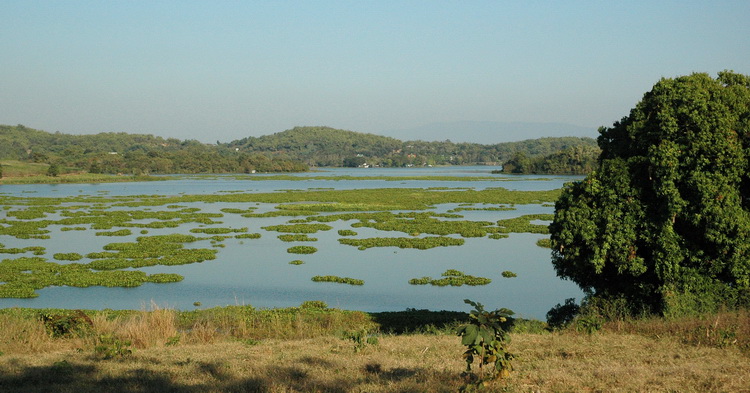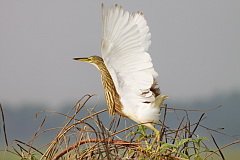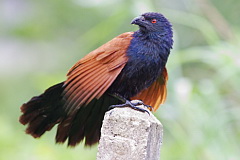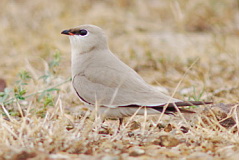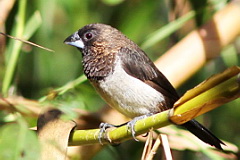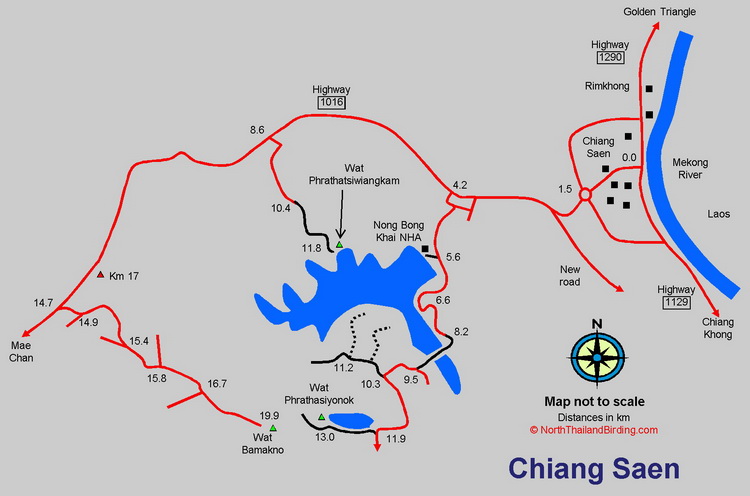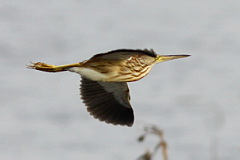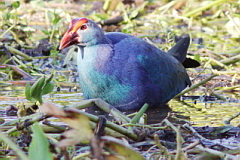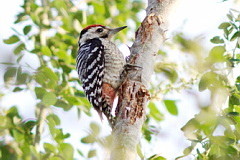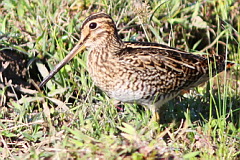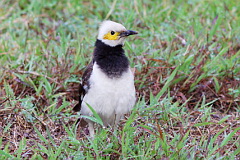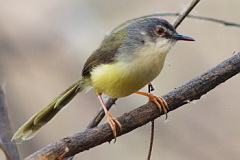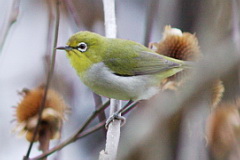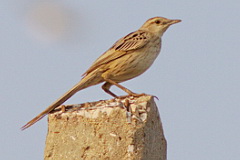Overview
Due to its geographical position, proximity to the Mekong River and a large, natural, inland body of fresh water Chiang Saen has long been a premier rarity and migrant hotspot of northern Thailand. Unfortunately in the last few years the area has seen massive development for tourism and commerce, as well as huge swaths of scrubland converted to agriculture. This, coupled with sand and gravel extraction, dredging, and bank concreting, has resulted in the area having declined significantly in terms of attractiveness to birds and wildlife. Information on this page verified/accurate as of 17 Jan 2023.
Chiang Saen Lake - general view across northern shore
Chiang Saen Lake is the most important wintering area for wildfowl in northern Thailand, but receives no official protection other than at the small Nong Bong Khai Non-hunting Area at the northeastern corner of the lake. Formerly Bear's Pochard was a regular visitor but the dramatic decrease in its world population mean it is now less than annual.
Although numbers of wintering ducks continue to dwindle, the lake still holds a couple of hundred Indian Spot-billed Duck as well as small numbers of diving duck such as Ferruginous Duck, Tufted Duck and Common Pochard. The Mekong River formerly held a number of interesting species such as River Lapwing, Long-billed Plover, Small Pratincole, Jerdon's Bush Chat and Black-faced Bunting - though finding these now isunlikely. One of the world's largest Pied Harrier roosts is also found. Chiang Saen is an important historical city, pre-dating even Chiang Mai, and contains ruins of temples and chedis. |
|
|
Access
Chiang Saen lies along the Mekong River, about 15 kilometres south of the legendary Golden Triangle where Thailand, Burma and Laos meet. From Bangkok or Chiang Mai head north to Chiang Rai, turning off onto the airport access Highway 5023 just south of the city. Ten kilometres after the airport take the newly constucted Highway 1063 direct to Chiang Saen. Driving time from Chiang Mai is about three and a half hours, or 50 minutes from Chiang Rai.
Access points are given measuring from the centre of Chiang Saen where the main highway meets the Mekong. It should be mentioned that access to the lake and viewing points along the Mekong are not straightforward, and in a constant state of change due to development of land, agricultural expansion and closure of access. Surprisingly, despite its size the lake is not straightforward to access and view well - in part due to changes in access tracks as well as the invasive Mimosa which tends to run rampant and choke access.
Note that all unpaved tracks in the area are impassible to vehicles during the rainy season. During the dry season most are easily accessed although some areas definitely require a higher clearance vehicle.
Accommodation and Facilities
The proximity of the Golden Triangle means a good number of resorts and guest houses run right the way from Chiang Saen to the Golden Triangle. Cheaper, backpacker and guesthouse accommodation tends to be found in and around Chiang Saen town itself, with more fancy high end resorts bordering the Mekong nearer the Golden Triangle.
The town is not large, but has several convenience stores and restaurants. Most of the restaurants in town are not open late into the evening, but simple eating stalls can be found around the market at this time. Several restaurants can be found along the Mekong; those closer to Chiang Saen overlooking the river can be interesting in the late afternoon.
Birding
Loosely, birding opportunities can be split into three; the Mekong River, Chiang Saen Lake and the harrier roost, with the time of day and position of the sun important. Although situated at around 370 metres altitude, the area tends to have significant variations in temperature; rather hot by day and frequently cold in the evenings during the dry season. Early morning fog along the Mekong and across the lake is common at this time as well, sometimes not clearing until after 10:00 which can be somewhat frustrating.
Eastern and southern Chiang Saen Lake These sides of the lake are best viewed during the earlier part of the day. From the centre of town, head back toward Mae Chan, turning left after 4.2 kilometres. This is the main access to point for Chiang Saen Lake. Prior to the recent road widening this was well signed, and had a decorative archway, which will hopefully reappear. Currently this turnoff looks no different to any other of the numerous small turnings. Follow the road through the village to 5.6 kilometres where a dirt track runs right, a hundred metres, to the offices of the Nong Bong Khai Non-hunting Area. This whole corner of the lake is nominally protected, but fishing is rife. At the offices a small boardwalk loop is interesting, as is a general stroll around the adjacent trees and lake edge. Species possible in the area include Purple Sunbird and Burmese Shrike. In December 2016 the National Parks Department decided to introduce a 200 Baht entrance fee for foreigners to this area. Being so small this is not worthy of the price. The lotus cover provides habitat for Grey-headed Swamphen, Ruddy Crake, White-browed Crake, Cinnamon Bittern, Chestnut-capped Babbler, Lesser Coucal and sometimes Freckle-breasted Woodpecker and Racquet-tailed Treepie can be found. Wintering migrants include Dusky Warbler, Taiga Flycatcher and Chestnut-tailed Starling. A scan of this corner of Chiang Saen lake should reveal numerous Lesser Whistling Duck and Little Grebe. Continuing along the eastern side of the lake, some good vantage points start at around 6.6 kilometres from which, early morning only, a reasonable view of distant ducks might be obtained. Indian Spot-billed Duck should be readily found, but diving ducks such as Tufted Duck and Common Pochard are likely to be very distant. The stretch of road around here has some taller trees and can be good for a variety of resident and wintering species such as Black-headed Bulbul, Yellow-browed Warbler, Black-collared Starling and Thick-billed Warbler. The lake edge often holds Pin-tailed Snipe. This whole eastern side of the lake is worthy of an early morning walk for a good selection of species. |
|
To access the southern shore of the lake turn right at 9.5 kilometres, and right again at 10.3 kilometres onto a very rough track. Although this wide track runs along the south side of the lake, it is approximately a kilometre from it and the lake out of sight. To access and scan the lake it is necessary to find access tracks through the farmland and cultivation.
|
These accesses change frequently and can be lost due to fencing of private land, becoming overgrown, or crop cultivation. It would be polite to ask if attempting to cross private land here. Traditionally, a wide track can be found at 11.2 kilometres, which was accessible by vehicle for some years, but is now partly overgrown with bamboo and Mimosa making access by foot necessary. Another area worthy of investigation, and with good access, is the track past Wat Phrathasiyonok which is found by turning off at 11.9 kilometres. The water body here is banked, so does not hold any waterfowl, but the scrub, trees and water edge can be good. |
The track eventually peters out 500 metres beyond the temple a few hundred metres across from Wat Bamakno.
Northern Chiang Saen Lake
This side of the lake can be accessed from the Nong Bong Khai Non-hunting Area or scanned from near Wat Phrathatsiwiangkam. Rough tracks, passable in the dry season, can be found right of, and behind, the Non-hunting area office. However, although these offer some views across the lake, duck are almost always too distant to identify, and the sun direction most of the day is terrible.
A better bet, late afternoon is to drive the road and track toward Wat Phrathatsiwiangkam, which is found by turning off the highway 8.6 kilometres from town. This access is initially paved but after 1.8 kilometres becomes a wide, dusty dirt road. The last kilometre from the temple offers good scope views to wet areas to the east, and near the temple the central area of the lake can be scanned, although the eastern end is still obscured by surrounding hillsides which are private property. Scrub and swampy vegetation hold a selection such as Striated Grassbird, Yellow Bittern, Cinnamon Bittern, Plain Prinia, Long-tailed Shrike, Common Kingfisher, Lanceolated Warbler and Yellow-bellied Prinia. Chinese Francolin frequently calls in the late afternoon. |
|
Mekong River
Wherever access can be found, north or south of Chiang Saen, the Mekong and surrounding scrub can be investigated. During the dry season large sand bars appear both upstream and downstream of Chiang Saen and are attractive to a variety of waders. Unfortunately massive disturbance along both the Thai and Lao sides have led to a dramatic decrease in bird numbers. Small Pratincole still attempt to breed in good numbers on these bars but are subject to a ruthless campaign of nest marking and egg removal by locals, to such an extent it's incredible that they still attempt to breed.
|
Three kilometres to the north of Chiang Saen, lies the Rimkhong Resort, which has for long been one of the better areas to view the sand bars, which can be scanned even from the restaurant. A good access track to the river, just south of here, has now been fenced off. Scanning points can still be found for about a kilometre north of the Rimkhong, where species likely to be found include Grey-throated Martin, Little Pratincole, Temminck's Stint, Common Greenshank and Little Ringed Plover. Until recently River Lapwing was reliable in the wintering months, as well as Long-billed Plover and Ruddy Shelduck. In some years Common Ringed Plover turns up. Further vantage points can be found heading south of Chiang Saen along the highway to Chiang Khong, although for lengthy sections access is not possible, or the road is distant from the river. Simply stop and scan wherever possible. The new port, about 10 kilometres south of town has closed off a large section of river access. The first 20 kilometres or so from Chiang Saen should provide a sufficient selection of habitats with birds such as Pied Kingfisher, Ruddy Shelduck, Grey-throated Martin, Red Avadavat, Grey-breasted Prinia, Yellow-bellied Prinia, Lesser Coucal, Swinhoe's White-eye and Chestnut-capped Babbler. Those seeking out Jerdon's Bush Chat, which is still rather rare here, can continue farther toward Chiang Khong scanning the adjacent scrub and more farmland. After about 30-35 kilometres from Chiang Saen the river becomes more rocky with a greater possibility of coming across River Lapwing. |
Wat Pa Mak No Harrier Roost
The flooded grass and swampland adjacent to Wat Pa Mak No is probably the world's largest and most important wintering harrier roost. Birds are present from October to April with peak numbers of a few hundred individuals during mid winter. The composition, and number of birds appearing nightly, tends to be quite variable as there is at least one further roost outside the Chiang Saen area. Usually the composition is mostly Pied Harrier with many stunning adult plumaged males. Eastern Marsh Harrier make up the the rest, with rarely a Western Marsh Harrier or Hen Harrier putting in an appearance, although these are undoubtedly overlooked due to identification problems in fading light.
|
The road to the temple, another difficult to identify turning off the main highway, is located 14.7 kilometres from town, 500 metres after the Km 17 marker when coming from town. Turn here, and after 200 metres turn left, signed in Thai, toward the temple. Follow this road for about six kilometres, bearing left, right and left at minor intersections, to reach the temple. The temple entrance is marked with a large archway. Just before this temple, on the left is a wide dirt track, running along left side of a large swampy area. The best viewing areas vary, but as the area is very open, specific viewing areas can be chosen on the evening. |
Most harriers arrive at dusk, with some arriving when almost dark. The same area is an important roost for thousands of Red-throated Pipit. The area was previously know for Eastern Grass Owl, but these now appear to have abandoned the area through increased disturbance. Eastern Barn Owl occurs. Whilst waiting for the harriers, other birds may include Chestnut-tailed Starling, Lanceolated Warbler, Common Kingfisher, Ruddy-breasted Crake, Common Iora, Common Kingfisher, Shikra, Striated Grassbird or similar. It can be surprisingly cool here in the height of the dry season, so come prepared.
Checklist
Checklist of species.
Gallery
Additional images from Chiang Saen available in the Thailand Travel gallery.
Sunrise and Sunset
Detailed sunrise and sunset times.

